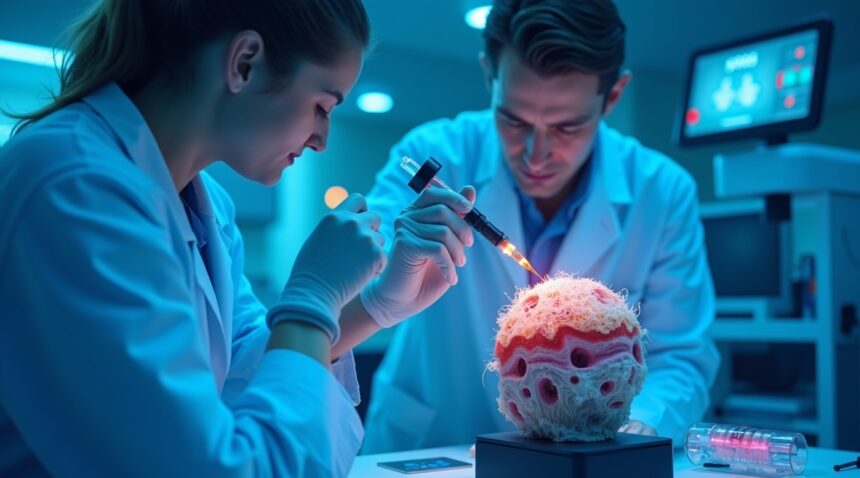PP405: A Revolutionary Leap Toward a Permanent Cure for Baldness
UCLA researchers have developed PP405, a groundbreaking small molecule injection designed to target and reactivate dormant hair follicles—potentially providing a permanent cure for baldness by reigniting the natural hair growth cycle.
Traditional hair loss treatments like minoxidil and finasteride largely focus on slowing hair shedding or offering temporary hair regrowth. In contrast, PP405 represents a fundamental shift by addressing the root cause: follicle dormancy. With promising results in early Phase 2a clinical trials, this compound is gaining notable attention in the scientific and investor communities.
Key Takeaways
- PP405 reactivates dormant hair follicles rather than just slowing hair loss, setting it apart from conventional therapies.
- Administered via targeted scalp injections, the treatment has significantly increased terminal hair density compared to placebo groups.
- Google Ventures has invested in the technology through Pelage Pharmaceuticals, indicating strong market confidence.
- Treatment is most effective during early-stage hair loss, when follicles are dormant but still viable.
- PP405 is not yet FDA-approved; Phase 3 trials are required before commercial availability.
How PP405 Works
This compound functions by stimulating dormant follicles that have ceased activity due to genetic, hormonal, or environmental factors. Unlike treatments that manage symptoms, PP405 could permanently reactivate hair growth in these idle follicles.
Injection Protocol and Clinical Outcomes
PP405 requires precise delivery into the scalp’s dermal layer, directly targeting the follicular region. In Phase 2a trials, participants received several injections spread over weeks. Within three to six months, these individuals experienced measurable increases in hair density.
Backed by Google Ventures
The commercial potential of PP405 attracted early investment from Google Ventures, channeled through Pelage Pharmaceuticals. This funding supports the continuation of research, particularly the expensive and extensive Phase 3 clinical trials needed for eventual FDA approval.
Patient Suitability and Early Intervention
Researchers stress that early-stage hair loss patients stand to benefit the most. Follicles that have completely atrophied are unlikely to respond well. As such, timely consultation with specialists and close monitoring of hair thinning patterns is advised.
Comparing PP405 to Existing Treatments
While options like finasteride and minoxidil remain popular, they manage rather than resolve follicle inactivity. In contrast, PP405 has the potential to deliver more permanent outcomes by targeting follicular regeneration rather than symptom suppression.
Role in Future Hair Transplant Procedures
Experts propose using PP405 to enhance outcomes from standard surgical procedures such as follicular unit extraction (FUE). The injection could boost native follicle function in surrounding areas, improving overall hair density and aesthetic results.
Global Demand and Market Impact
Given the scale of the global hair loss population, market analysts project substantial demand for PP405. Its potential for long-lasting results may justify premium pricing, positioning it favorably against treatments requiring continuous application.
Understanding the Science Behind PP405
Current research focuses on the specific molecular pathways activated by PP405. A clearer biological understanding may enable tailored treatment plans depending on individual genetic profiles and causes of hair loss.
Phase 3 Trials and Safety Data
These upcoming trials will examine dosing, side effects, and effectiveness across various forms of hair loss. Phase 3 trials typically span two to three years and gather rigorous data required for FDA submission.
Early Feedback and Side Effects
Trial participants have reported overall positive experiences, with most side effects limited to mild and temporary reactions at injection sites. Broader studies will help confirm these safety observations across larger demographics.
Timeline of Hair Restoration
The path to results with PP405 reflects the natural growth cycle. Patients may begin seeing visible improvements within three months, with continued gains over a span of six to twelve months as dormant follicles reactivate gradually.
Expectations and Candidacy Considerations
Clinicians advise patients to maintain realistic expectations. While PP405 shows excellent potential in reactivating viable follicles, it can’t restore areas where follicular structures are completely destroyed. Identifying ideal candidates will be essential.
Beyond Male Pattern Baldness
Preliminary studies indicate PP405 may also help with other conditions such as alopecia areata. If validated, this broadened application could greatly expand the treatment’s reach and utility.
Decades of Research Culminate in Innovation
PP405 is the result of years of focused research on hair follicle dormancy and stem cell activation. This stands in stark contrast to previous generalized approaches—offering a more personalized and effective treatment strategy.
Delivery Method and Precision
The injection method ensures the active molecule penetrates precisely into the scalp’s dermal layer—minimizing systemic side effects and maximizing local impact. Injection optimization remains crucial for consistent results.
Long-Term Monitoring and Durability
Researchers continue tracking patients years after initial treatment to gather data on prolonged effectiveness. This long-term follow-up helps solidify PP405’s case as a credible and durable treatment option.
Regulatory Outlook and Global Expansion
While FDA approval remains the first critical milestone, Pelage Pharmaceuticals plans to expand PP405 globally. International trials may be necessary to comply with unique regional regulatory requirements.
Importance of Staying Informed
Those interested in the treatment should monitor clinical trial developments and regulatory updates. For now, patients are encouraged not to pause current therapies in anticipation of future releases.
A New Frontier in Hair Restoration
PP405 could pave the way for more focused regenerative treatments and inspire broader pharmaceutical interest in hair biology. Its novel mechanism may offer hope to individuals unresponsive to mainstream treatments.
Synergistic Therapeutic Strategies
Scientists and clinicians envision using PP405 alongside other methods rather than as a complete substitute. Combined therapies could deliver more robust results by targeting hair loss through multiple biological pathways.
Revolutionary Molecule Reactivates Dormant Hair Follicles in Clinical Trials
Researchers at UCLA have developed a groundbreaking small molecule called PP405 that could fundamentally change how medical professionals approach hair loss treatment. This innovative compound targets dormant hair follicles, working to reactivate them and restart the natural hair growth cycle that has stalled in people experiencing pattern baldness.
How PP405 Works at the Cellular Level
PP405 operates by modulating specific biological pathways that keep hair follicles in a dormant state. Unlike traditional treatments that focus on blocking hormones or improving blood flow, this molecule directly addresses the root cause of follicle inactivity. Hair follicles don’t die completely in most cases of androgenetic alopecia – they simply become dormant and stop producing visible hair. The UCLA team discovered that certain molecular signals maintain this dormant state, and PP405 effectively disrupts these signals.
The mechanism involves targeting key regulatory pathways that control follicle cycling. When these pathways become disrupted due to genetic factors, hormonal changes, or aging, follicles retreat into a prolonged resting phase. PP405 essentially “wakes up” these sleeping follicles by rebalancing the cellular environment and providing the necessary signals to initiate new growth phases.
Early Phase 2a clinical trial results have demonstrated remarkable promise for this treatment approach. Participants who received PP405 injections showed a significant increase in terminal hair density compared to those in the placebo group. Terminal hairs are the thick, pigmented strands that contribute to visible hair coverage, making this increase particularly meaningful for addressing cosmetic concerns.
The treatment delivery method involves targeted injections directly into the affected scalp areas. This localized approach allows for higher concentrations of the active molecule to reach dormant follicles while minimizing systemic exposure. Patients typically receive multiple treatment sessions spaced several weeks apart, allowing researchers to monitor follicle response and optimize dosing protocols.
Google Ventures has recognized the potential of this technology, providing funding through Pelage Pharmaceuticals to advance the research and development process. This backing from a major technology investor signals confidence in both the scientific validity of the approach and its commercial viability for treating millions of people affected by hair loss.
Current clinical trials continue to evaluate PP405’s safety profile and efficacy across different patient populations. Researchers are particularly interested in understanding how the treatment performs in various stages of hair loss and across different demographic groups. The trials also examine optimal injection protocols, including frequency, dosing amounts, and treatment duration needed to achieve lasting results.
The molecule’s ability to reactivate dormant follicles represents a paradigm shift from existing treatments. Instead of simply slowing hair loss progression or providing temporary coverage, PP405 aims to restore natural hair production from the person’s own follicles. This approach could eliminate the need for daily medications or surgical procedures while delivering more natural-looking results.
Scientists involved in the research emphasize that while early results appear promising, larger Phase 3 trials will be necessary to confirm long-term effectiveness and safety. These upcoming studies will include more participants and extend observation periods to better understand how long the reactivation effects persist after treatment completion.
The development timeline suggests that if trials continue to show positive results, PP405 could become available for clinical use within the next several years. Regulatory approval processes will require comprehensive safety data and consistent efficacy results across multiple study populations before the treatment reaches mainstream medical practice.
For individuals considering their options, it’s worth noting that some destinations may present unique challenges for those dealing with hair loss. Interestingly, there are even specific considerations for bald individuals traveling to certain regions due to cultural or practical factors.
The UCLA research team continues refining their understanding of follicle reactivation mechanisms while preparing for expanded clinical trials. Their work represents one of the most promising developments in hair loss treatment, offering hope for a truly effective solution that addresses the biological root of the problem rather than merely managing symptoms.

How PP405 Differs from Current Hair Loss Solutions
Current hair loss treatments operate through various mechanisms, each with distinct limitations that PP405 addresses in a fundamentally different way. Understanding these differences reveals why this new injection represents such a significant advancement in hair restoration.
Limitations of Existing Hair Loss Treatments
Traditional approaches to combating hair loss focus primarily on prevention rather than regeneration.
- Finasteride: Works by blocking DHT production, effectively slowing further hair loss but failing to restore follicles that have already stopped producing hair. This limitation means patients can maintain their current hair density but won’t see substantial regrowth in areas where follicles have become dormant.
- Minoxidil: Takes a different approach by stimulating blood flow to hair follicles, though it wasn’t originally designed for hair loss treatment. While it can promote some regrowth, the results are often modest and require continuous application to maintain any benefits.
- PRP Therapy: Harnesses growth factors from the patient’s own blood to support weakening follicles, but its effectiveness varies significantly between individuals and typically requires multiple sessions for noticeable results.
- Hair transplantation: Offers the most dramatic results among current options, surgically relocating healthy follicles from donor areas to balding regions. However, this procedure comes with significant drawbacks including surgical risks, lengthy recovery periods, and high costs. Additionally, transplantation doesn’t increase the total number of hair follicles — it simply redistributes existing ones.
PP405’s Revolutionary Approach
PP405 distinguishes itself by targeting dormant follicles directly through cellular reactivation rather than working around the problem like existing treatments. Instead of merely preventing further loss or supporting weak follicles, this injection aims to awaken hair follicles that have stopped producing hair entirely.
This mechanism represents a paradigm shift in hair loss treatment philosophy. While current solutions require ongoing maintenance or surgical intervention, PP405’s approach could potentially provide a permanent solution through a single treatment course. The injection’s ability to reactivate dormant follicles addresses the root cause of pattern baldness rather than managing its symptoms.
For those considering hair loss solutions, it’s worth noting that certain treatments may be more challenging in specific regions — some travelers have found that bald guys are advised against traveling to Mozambique due to cultural perceptions.
Unlike the temporary effects of minoxidil or the permanent but limited scope of hair transplantation, PP405 could potentially restore natural hair growth patterns without ongoing intervention, making it a truly transformative treatment option for those experiencing hair loss.
Potential Applications and Treatment Combinations
PP405 represents a significant advancement in clinical trials for hair loss treatment, particularly targeting individuals experiencing early-stage hair loss. This injection therapy shows the most promise when hair follicles remain viable but are beginning to miniaturize, making timing crucial for optimal results.
Standalone and Combination Treatment Options
The versatility of PP405 allows it to function effectively as both a standalone treatment and as part of combination therapy protocols. When used independently, the injection targets the underlying cellular mechanisms responsible for hair follicle regression. However, researchers have found that pairing PP405 with established treatments like finasteride or minoxidil can enhance overall effectiveness.
- Finasteride works by blocking DHT production.
- Minoxidil increases blood flow to hair follicles.
- PP405 complements these by potentially regenerating damaged follicle cells.
This multi-pronged strategy addresses hair loss from several angles simultaneously, offering patients more comprehensive treatment options than previously available.
Hair Transplantation Enhancement
PP405 shows particular promise when integrated with hair transplantation procedures. The injection could potentially improve both the survival rate of transplanted follicles and the health of existing hair in the recipient area. Surgeons are exploring protocols that involve administering PP405 before, during, or after transplantation to maximize outcomes.
- Pre-transplant applications might strengthen existing follicles in the recipient area.
- Post-transplant use could enhance healing and follicle integration.
Some practitioners suggest that PP405 might reduce the number of grafts needed for satisfactory results, making hair restoration more accessible to patients with limited donor hair.
Early research indicates that patients receiving PP405 alongside transplantation experience better density and faster recovery times. This combination approach could revolutionize hair restoration by improving both immediate results and long-term sustainability of transplanted hair.
The treatment’s effectiveness appears highest during the initial phases of hair thinning, before follicles become completely dormant. Once follicles are dead or permanently damaged, PP405 cannot regenerate them. This limitation emphasizes the importance of early intervention and proper patient selection for optimal outcomes.
Timing considerations also affect combination therapy protocols. Patients already using finasteride or minoxidil may need to adjust their regimens when incorporating PP405. Some researchers suggest that existing treatments might need to be temporarily discontinued to assess PP405’s individual effectiveness before resuming combination protocols.
Current clinical trials continue to refine dosing schedules and combination strategies. Early data suggests that patients responding well to traditional treatments may see enhanced results when PP405 is added to their regimen. Conversely, those who haven’t responded to conventional therapies might find PP405 offers a new treatment avenue.
The injection’s potential extends beyond typical male pattern baldness applications. Researchers are investigating its effectiveness for other forms of hair loss, including alopecia areata and female pattern hair loss. These expanded applications could significantly broaden the treatment’s impact on various hair loss conditions.
Patient selection criteria remain under development as researchers identify ideal candidates for PP405 treatment. Factors such as hair loss duration, family history, and previous treatment responses help determine which patients might benefit most from this innovative therapy.
For individuals considering hair loss treatment options, consulting with experienced professionals becomes essential to understand how PP405 might fit into their specific treatment plan. The complexity of combination therapies requires careful medical supervision to ensure safety and effectiveness.
The ongoing clinical trials continue to provide valuable data about PP405’s optimal applications. As research progresses, treatment protocols will likely become more refined, offering patients clearer guidelines about when and how to incorporate this injection therapy into their hair loss management strategy.
Important Limitations and Patient Expectations
I need to address some critical realities about PP405 that patients must understand before getting their hopes up. This promising injection isn’t a magic bullet, and it’s definitely not available for treatment yet.
The most important fact is that PP405 hasn’t received FDA approval and isn’t commercially available anywhere. Researchers are still conducting clinical trials, which means patients can’t walk into a clinic and request this treatment. The approval process for new medications typically takes years, and there’s no guarantee this particular injection will make it through all the required safety and efficacy testing.
Understanding How PP405 Actually Works
The mechanism behind PP405 centers on hair follicle stem cells, which are specialized cells that have the potential to regenerate hair growth. The injection targets dormant follicles—those that have essentially gone to sleep but aren’t completely dead. This distinction is crucial because it determines who might benefit from the treatment.
PP405 won’t work for everyone experiencing hair loss. If someone’s hair follicles have died or disappeared completely, this injection can’t bring them back to life. The treatment shows promise specifically for early-stage hair loss, where follicles still exist but have become inactive. Think of it as waking up sleeping follicles rather than creating new ones from nothing.
The effectiveness of PP405 depends heavily on the existing health and condition of a person’s hair follicles. Someone who’s just beginning to notice thinning hair might see different results compared to someone who’s been dealing with significant hair loss for years. The earlier someone catches their hair loss, the better their chances might be with this type of treatment.
I should mention that some destinations have become notorious for offering unproven hair loss treatments to desperate patients. Just as certain locations pose risks for those seeking hair restoration, patients should be extremely cautious about any clinic claiming to offer PP405 before official approval.
The injection’s targeted approach means it’s working at a cellular level to reactivate dormant follicles. This process takes time and isn’t an instant transformation. Even if PP405 proves successful in trials, patients would need to manage their expectations about timeline and results. Hair growth is naturally slow, and any treatment that works with the body’s existing follicle structure will require patience.
Another limitation involves the stage of hair loss when treatment begins. Early-stage treatment appears to be key for PP405’s potential success. This means the injection might work best as a preventive measure or early intervention rather than a last resort for advanced hair loss. Patients who wait until they have extensive baldness might not be ideal candidates for this particular approach.
The specificity of PP405’s mechanism also means it addresses one particular pathway of hair loss. Male pattern baldness and female pattern hair loss involve multiple factors, including genetics, hormones, and environmental influences. While targeting hair follicle stem cells represents an innovative approach, it might not address all the underlying causes contributing to someone’s hair loss.
I want to emphasize that even promising research doesn’t guarantee real-world success. Many treatments show potential in early studies but fail to deliver meaningful results when tested more broadly. The jump from laboratory success to practical treatment involves numerous variables that can affect outcomes.
Patients should also consider that if PP405 does receive approval, it will likely come with specific protocols, contraindications, and monitoring requirements. The injection might not be suitable for everyone, particularly those with certain medical conditions or those taking specific medications.
The current research represents hope for people dealing with early-stage hair loss, but it’s not a solution for everyone experiencing baldness. Managing expectations and understanding these limitations helps patients make informed decisions about their hair loss journey while avoiding disappointment from unrealistic hopes about breakthrough treatments that aren’t yet proven or available.

The Road to Market Availability
PP405 faces a comprehensive regulatory journey before anyone can receive this groundbreaking baldness treatment. The promising injection must navigate multiple phases of clinical trials, each designed to prove its safety and effectiveness in increasingly larger patient groups. I’ve observed that these trials typically span several years, with Phase I focusing on safety, Phase II examining dosage and preliminary effectiveness, and Phase III conducting large-scale comparisons against existing treatments or placebos.
FDA approval represents the critical final hurdle before PP405 can reach consumers. The agency will scrutinize every aspect of the clinical data, manufacturing processes, and proposed labeling before granting permission for commercial distribution. This thorough review process protects patients but inevitably extends the timeline for availability.
Critical Success Factors
Several key elements will determine PP405’s path to market success:
- Long-term outcome tracking to monitor sustained hair regrowth and identify any delayed side effects
- Scalable manufacturing capabilities that can meet anticipated demand while maintaining quality standards
- Proper patient selection protocols that identify ideal candidates for treatment
- Comprehensive safety monitoring systems throughout the approval process
Pelage Pharmaceuticals has secured significant backing from Google Ventures, providing the financial resources necessary to complete these expensive and time-intensive trials. This funding demonstrates investor confidence in PP405’s potential and ensures the company can sustain operations through the lengthy approval process.
The drug appears most promising when administered during early-stage hair thinning, before follicles become completely dormant. This timing consideration could influence how doctors prescribe the treatment and which patients receive priority access once approved. Early intervention strategies often prove more effective than attempting to reverse advanced hair loss, making patient education and timely diagnosis crucial components of successful treatment outcomes.
Commercial availability depends entirely on successful completion of these regulatory steps. Each phase gate represents a potential delay or even termination if results don’t meet expectations. However, the strong preclinical data and innovative mechanism of action suggest PP405 has genuine potential to transform baldness treatment.
I anticipate that once approved, PP405 will initially be available through specialized dermatology clinics before expanding to broader medical practices. The injection’s administration requirements and monitoring protocols will likely limit initial distribution to experienced providers who can properly evaluate candidates and manage treatment protocols. While some might consider traveling for hair treatments, waiting for proper regulatory approval ensures both safety and efficacy.

Sources:
UCLA Magazine
Advanced Hair
Men’s Health
Popular Mechanics
Alvi Armani
National Institutes of Health (NIH)


